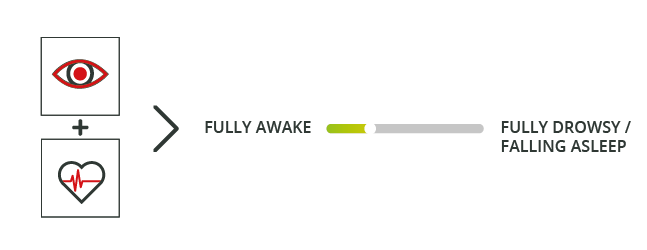What is drowsiness?
Drowsiness, also known as sleepiness or fatigue, is the intermediate state between wakefulness and sleep. It can be seen as a physiological state where an individual is inclined to sleep and has difficulty to stay awake. Drowsiness induces impairments of performances leading sometimes to accidents in transportation and in industry.
Our solutions for drowsiness monitoring
Phasya offers and develops software modules for measuring the level of drowsiness from the analysis of ocular data (e.g. blinks), cardiac data (e.g. heart rate variability), or the combination of both data. According to the available data and their specifications, our software modules can output the level of drowsiness on a scale up to 11 levels (from ‘0’ well awake to ’10’ very drowsy/falling asleep). Our technology for drowsiness monitoring is validated with the analysis of electroencephalogram, performances in driving simulator (e.g. lane departure), and reaction time tests.
Furthermore, Phasya offers software modules for extracting ocular data from eye images and face images.
Drowsiness measurement from ocular data
This software module for measuring drowsiness is based on the analysis of one or several eye features such as eyelids gap (i.e. eye opening) and pupil position. This module is adaptive to various specifications of ocular data (resolution and sampling rate) and can output a level of drowsiness on a scale up to 11 levels (from ‘0’ to ‘10’).
The level of drowsiness determined by this software module is more relevant and reliable than the solutions only based on the PERCLOS. Indeed, the correlation between the indicators of drowsiness in the electroencephalogram (EEG) and the level of drowsiness determined by our technology is higher than the correlation between the indicators of drowsiness in the electroencephalogram (EEG) and the PERCLOS.
Phasya can also deliver an image processing module for extracting the required eye features from images of the eye or images of the face.

Drowsiness measurement from cardiac data
This software module for measuring drowsiness is based on the analysis of heart rhythm features such as heart rate variability. This module is adaptive to various specifications of cardiac data (resolution and sampling rate) and can output a level of drowsiness on a scale up to 11 levels (from ‘0’ to ‘10’).

Drowsiness measurement from data fusion
This software module for measuring drowsiness is based on the analysis of ocular data and cardiac data. This module is adaptive to various specifications of ocular and cardiac data (resolution and sampling rate) and can output a level of drowsiness on a scale up to 11 levels (from ‘0’ to ‘10’).
The combination of ocular and cardiac data enables a better accuracy of the drowsiness measurement. Furthermore, this approach can reduce the measurement sensitivity to data loss caused by disturbances in the data sensing modalities.

